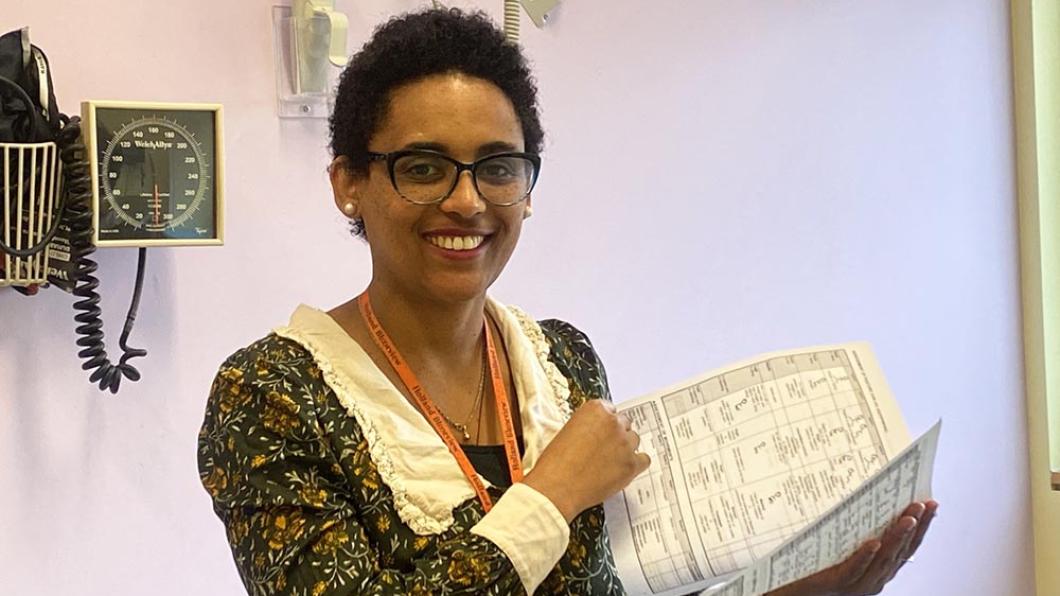
In Ethiopia, early diagnosis improves care of kids with cerebral palsy
By Louise Kinross
In Canada, children with cerebral palsy are usually diagnosed before they're 18 months old. In Ethiopia, the average age is five-and-a-half years—missing a critical window for therapy that can improve a child’s life.
Dr. Selamenesh Tsige (above), a former pediatrician at Addis Ababa University hospital, knew this firsthand.
So while completing a fellowship in developmental pediatrics at Holland Bloorview, she worked with staff and residents at Addis Ababa University to train clinicians to use an early identification tool.
The Hammersmith Infant Neurologic Examination (HINE) is “a basic, scorable, standardized neurological exam that focuses on motor impairments,” for children aged two months to two years, Selamenesh says. It’s used widely in Ontario, and Selamenesh learned to use it here.
Clinicians score 26 items in areas like posture, movement and muscle tone using a two-page document with simple pictures “that can be completed in five to 10 minutes once you’re acquainted with it,” Selamenesh says.
In children with pre-existing risk factors for cerebral palsy, the HINE is more than 90 per cent accurate in predicting children with a high probability of cerebral palsy. Children are then assessed clinically and with brain imaging to confirm the diagnosis.
The goal of Selamenesh’s research was to reduce the average age of diagnosis in Ethiopia to under 12 months by integrating the HINE into clinical practice. This would enable children to receive timely referrals to rehab.
She identified three clinics who see children in the under-two age group: a high-risk infant clinic, a pediatric neurology clinic and a pediatric developmental clinic.
She trained the heads of these clinics on the HINE tool over Zoom, then worked with Ethiopian staff and Holland Bloorview clinicians to lead seven Zoom training sessions attended by 54 Ethiopian pediatric residents. The workshops were 90 minutes to two hours long, and used a doll, pictures and videos. Staff in Ethiopia helped residents practice using the assessment in clinic.
Due to the eight-hour time difference, the workshops were held at 5 or 6 a.m. Toronto time. To introduce all staff to the HINE, Selamenesh did one presentation at 1 a.m. Toronto time.
Trainees received a package of educational materials and a video. “One of the challenges was that we don’t have access to printers in these clinics,” Selamenesh says. “Eventually, Dr. Darcy Fehlings was able to get a grant to purchase a printer that the clinics can share.”
The HINE was used in the three clinics over six months.
More than 100 children were assessed and 98 presented with risk factors. Of these 98, 14 children received a cerebral palsy diagnosis and got referred for treatment. Another 20 who didn’t meet the threshold for diagnosis but had a high probability of cerebral palsy also received therapy, as did 16 other children who scored with a lower likelihood of cerebral palsy. Additional children will continue to be monitored. The mean age of children identified with a high probability of cerebral palsy was 10.7 months.
Prior to the project, Ethiopian clinicians didn’t have a tool for early diagnosis or a process for referring young children to therapy.
They could address a medical need like prescribing seizure medication, but they couldn’t intervene to support a child’s functional and developmental needs. Families didn’t feel heard, and often stopped bringing their children for medical visits.
“We had so many positive responses to the HINE training,” Selamenesh says. “One that really stays in my heart is pediatric residents told us that the training decreased [a] sense of worthlessness they used to feel when dealing with children with cerebral palsy. Now they can identify them early, before they develop significant functional impairments, and connect them with available rehab centres in the city.”
Ethiopian staff and residents reported that “families felt like their concerns were validated, and they were being seen,” Selamenesh says.
Selamenesh is pleased to report that the HINE tool has been adopted by clinicians at Addis Ababa University hospital and is even now part of the medical residents’ assessment. She will publish her findings.
The international practice guideline for cerebral palsy recommends an early diagnosis of cerebral palsy before the age of 12 months, and outlines tools to be used as early as five months, including the HINE.
Selamenesh just graduated from the developmental pediatrics fellowship at Holland Bloorview and is the first Ethiopian to become a developmental pediatrician.
Read more about Selamenesh in this earlier BLOOM piece about her. Like this content? Sign up for our monthly BLOOM e-letter, follow @LouiseKinross on Twitter, or watch our A Family Like Mine video series.